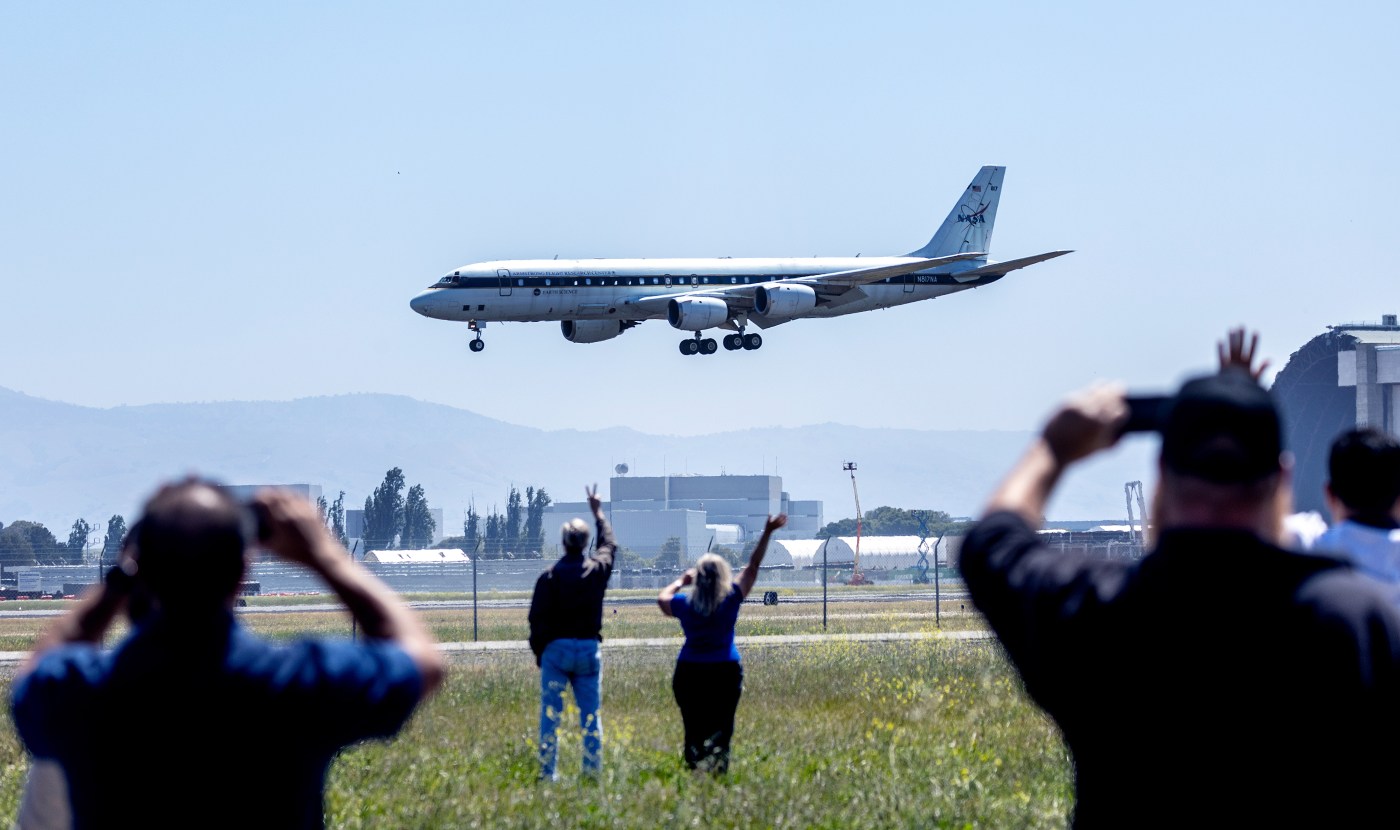For many NASA scientists, flying aboard a decked-out Douglas DC-8 plane provided them some unique glimpses of Earth: the Moai on Easter Island, Central Park in New York and Mount Vesuvius in Italy.
On Wednesday, some of the same scientists who worked on that “flying laboratory” looked on as it made one last flight over Ames Research Center in Mountain View before its retirement.
Reem Hannun, a researcher at Ames Research Center brought her 3-year-old twins Lina and Joud out to wave goodbye to NASA’s venerable DC-8 Flying Laboratory making a final flyby at Moffett Field, Wednesday, May 15, 2024. (Karl Mondon/Bay Area News Group)
Reem Hannun, a research scientist in the atmospheric science branch, attended the flyover with her two children before taking them to school. As the twins played around the trees and commented on the big plane that flew close to the ground for them to see, she recalled how she got her start at NASA doing science and reading field measurements on the plane.
“It’s just cool to see all these different measurements for atmospheric composition, and it’s a great community to be a part of, and you get to travel the world doing science,” Hannun said.
The plane, owned by NASA, was one of seven DC-8 planes still in operation internationally. Thomas Matthews, lead operations engineer for the aircraft and main mission director, said that NASA used the plane for 37 years, but the aging aircraft needed to be replaced as it was getting harder to sustain. A new Boeing-777 will replace the DC-8, which will retire at the aircraft maintenance school at Idaho State University in Pocatello.
Johny Zavaleta, a project manager at Ames Research Center, watches as NASA’s venerable DC-8 Flying Laboratory makes a final flyby at Moffett Field, Wednesday, May 15, 2024, in Mountain View, Calif. (Karl Mondon/Bay Area News Group)
Jhony Zavaleta, a project manager with the Earth Science Project Office, said he normally does not need to ride the plane for missions, but that he took every opportunity he could to climb aboard. He recalled one of the many flights the plane had taken over Antarctica between 2011 and 2017, calling it the “most amazing scenery you could see.”
The flight was part of Operation IceBridge, which aimed to continue collecting data on polar ice while NASA was switching satellites. Zavaleta recalled seeing mountain ranges and glaciers as far as the eye could see.
“I’d never seen anything so beautiful as that, (and) at the same time, so inhospitable,” Zavaleta said. “It was pretty nice, it was like being on another planet.”
The plane was originally a passenger aircraft with Alitalia, the former national airline of Italy, changing ownership to Braniff International Airways before it was eventually sold to NASA to be used at Ames Research Center in 1986, Matthews said.
Related Articles
California moves closer to requiring new pollutant-warning labels for gas stoves
The surprising force stalling climate progress: California restaurants
Big rigs in California are getting cleaner — but can long-range targets for trucks be met?
Few stations and $200 to fill up: Life on California’s ‘Hydrogen Highway’
Electric, hybrid cars cutting Bay Area’s carbon footprint, UC Berkeley researchers say
Matthews also reflected on his own experience seeing the awe-inspiring visuals while riding the plane over the Hudson River to record atmospheric conditions: The plane was flying about 2,000 feet above Manhattan, following the island’s coast and around the Statue of Liberty.
The moment — coming in low over America’s biggest city — was a culmination, he said, of all the coordination required to do some “low-level flying in some of the busiest places you can possibly fly while doing it safely.”
“It was an amazing thing to accomplish with amazing scenery as well, with all of the towers and seeing Central Park,” Matthews said.
The plane underwent numerous modifications to perform the research work, Matthews said, with added ports and racks for scientific components, new landing gear and engines at one point.
Chris Scofield, an assistant chief for the Earth science division at Ames Research Center, watches as NASA’s venerable DC-8 Flying Laboratory makes its final flight over Moffett Field, Wednesday, May 15, 2024, in Mountain View, Calif. (Karl Mondon/Bay Area News Group)
Those changes made it possible for the aircraft to gather data on air quality and climate investigations. Chris Scofield, a former research scientist on the DC-8, wiped away tears as she watched the plane fly off for the last time and recalled one of the most significant uses of data gathered on the aircraft.
Before she was brought onto the plane, Scofield said, the research was used to locate and measure a hole in the earth’s ozone layer in the 1980s, finding where chlorofluorocarbons — chemicals commonly used as refrigerants — were destroying ozone in the atmosphere. This discovery led to the passage of a 1987 global agreement phasing out the use of the chemicals and leading to a natural repair in the hole.
“The DC-8 actually was another part of the picture, so you could see, yes, it was really happening the way we think it is chemically,” Scofield said.
Jim Podolske, a research scientist at Ames Research Center, watches NASA’s venerable DC-8 Flying Laboratory making a final flyby at Moffett Field, Wednesday, May 15, 2024, in Mountain View, Calif. (Karl Mondon/Bay Area News Group)
Aside from being a main research vessel, the plane was a workplace with fond memories for many NASA employees. Jim Podolske, a research scientist who flew on the DC-8 for 21 years, praised the interactive community effort of about 40 scientists calling out interesting observations and making decisions together in real time.
“They have done some pretty amazing science, so I think the triple-7 has big shoes to fill,” Zavaleta said, mentioning the new plane that will replace the DC-8. “Through all this time, it kind of became the perfect platform for people to do research.”












